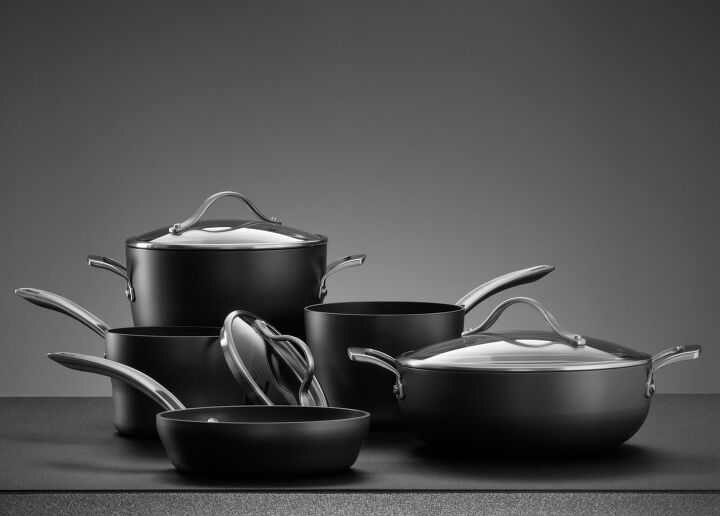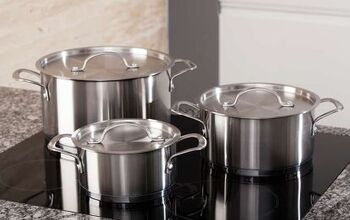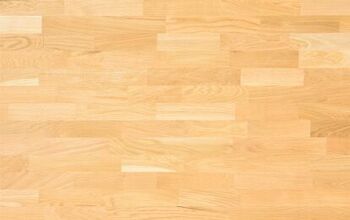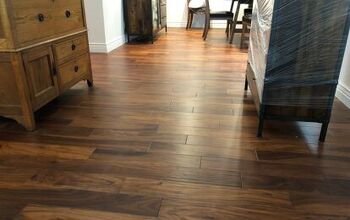Pros And Cons Of Hard Anodized Cookware

Every home chef knows the importance of having a set of quality cookware. Choosing the right pots and pans makes life simpler because you can prepare meals faster and better, and clean-up is easier. A popular choice for many home cooks is hard anodized cookware. But like any kitchen essential, it’s worth knowing the pros and cons before you buy.
Hard anodized cookware is durable, scratch-resistant, and good for making healthy meals. It’s also low-maintenance and provides even heating. However, hard anodized cookware is heavy, expensive, and can’t handle extremely high heat. Many people don’t like the look of hard anodized pots and pans, which stain easily on the exterior. They’re non-stick, but the coating only lasts a few years.
With so many choices for cookware, it can become overwhelming to pick the one that works best for you. If you’re considering hard anodized aluminum pots and pans, check out this list of pros and cons to decide if it’s the right move.
The Pros Of Hard Anodized Cookware
Hard anodized pots and pans have many benefits, including durability, healthy eating, easy maintenance, versatility, and even heating. Here’s a closer look at the pros of hard anodized cookware.
1. Hard Anodized Cookware Is Durable
During the anodizing process, an oxide layer forms around the cookware, providing corrosion resistance. It also strengthens the metal, reducing the chances of warping and other issues.
The increased durability provides scratch resistance, allowing you to use a variety of utensils without fear of damaging your cookware. Anodized pots and pans maintain a smooth surface longer than other types of cookware.
2. It Offers Even Heating
Anodized aluminum possesses excellent heat conductivity. Therefore, it heats up quickly and evenly, leading to better results when cooking. Plus, you can cook meals faster since you won’t have to wait as long for your pot to heat up.
Likewise, it also tends to cool down more quickly, too. So, you won’t have to wait as long to clean your cookware.
3. You Can Use It To Cook A Variety Of Foods
The durability and non-stick coating of hard anodized cookware makes it possible to cook a variety of foods. Whether making scrambled eggs, a fish filet, or burgers, you can prepare them with the same cookware.
4. Hard Anodized Aluminum Prevents Leaching Metals
Aluminum pots and pans can potentially leach metal into food when the non-stick coating starts to wear away. However, this is not the case with anodized cookware.
The anodizing process prevents the metal from corrosion, which means it won’t leach into your food. The process also stops various acidic foods, like vinegar or lemon juice, from reacting with the metal. Therefore, you don’t have to worry about ending up with a metallic aftertaste in your food.
5. Easy To Store
Often, people don’t like to stack their pots and pans because this can lead to scratching or damaging the cookware’s surface. Thanks to anodized cookware’s excellent durability and scratch resistance, you can stack the pots and pans without worrying about messing them up.
If you’re working with a small kitchen or limited storage options, this is an excellent feature. You can even find styles specifically designed to nest, like Calphalon Premier, making storage a breeze.
6. Non-Stick Coating Makes It Easier To Cook Healthier Meals
When you’re working with a non-stick coating on pots and pans, you don’t have to use so much butter and oil. This can help make it easier to keep these ingredients out of your meal prep or at least to a minimum.
7. Low Maintenance
The non-stick coating of hard anodized cookware makes it easy to clean. You won’t waste time scrubbing stubborn, stuck-on food off your pots and pans.
Also, you don’t need to season anodized aluminum cookware. So, you can use it right away and not bother with routine maintenance, like re-seasoning every few months.
The Cons Of Hard Anodized Cookware
Even though huge cookware names like Calphalon, Rachel Ray, and Anolon tout the praises of hard anodized cookware, there are still some drawbacks. As with anything you buy, you’ll find some up sides and some down sides.
Of course, the product’s quality and the brand’s reliability play a factor in how significant many of these disadvantages are. Therefore, take your time when choosing your cookware set and compare several options.
Here are the disadvantages of hard anodized cookware.
1. It Can Be Expensive
Hard anodized pots and pans are typically pricier, costing between $45 and $70 for one pan. (Although less expensive than stainless steel cookware.)
Of course, depending on the brand, you can find cheaper options (and more expensive ones). However, keep in mind the quality across brands can vary dramatically. Make sure you’re not sacrificing function, durability, and performance for the price.
2. Limited Design Choices
Most hard anodized cookware is gray or dark in color and dull because of the anodizing process. Therefore, you won’t find colorful and shiny options like you will with enamel or ceramic pots and pans. If you were hoping for your cookware to add a pop of color to your kitchen, this might not be for you.
3. The Exterior Stains Easily
Although the interior of the pots and pans maintains a smooth texture over time, the exterior tends to stain. This won’t affect the function of the cookware, but it will make it look unappealing. You might be able to remove the stains with some effort, but it depends on if you want to spend time doing it.
4. Hard Anodized Cookware Doesn’t Work With Induction Cooktops
If you have an induction cooktop or plan to get one, you’ll need to skip most of the hard anodized cookware available. The exception is a few models with a metal disc on the bottom, making them compatible with induction cooktops.
5. It’s Not Dishwasher-Safe
You can’t clean hard anodized aluminum pans in the dishwasher. However, you might not consider this a con since most people prefer to hand wash their pots and pans. Just make sure not to use abrasive scrubbers and sponges when cleaning your cookware.
6. Non-Stick Coating Wears Off In A Few Years
After spending a bit more on your anodized cookware, you probably hope it will last you for many years. However, the non-stick coating tends to wear down between two and five years, depending on how often you use your pots. Once this happens, you’ll need to start shopping for a new set of cookware.
7. Can’t Handle Extremely High Heat
Do you love the convenience of putting your pots and pans into your oven? Keep in mind hard anodized cookware can’t go over 500 degrees Fahrenheit. Otherwise, the nonstick coating breaks down and produces harmful fumes.
Does Hard Anodized Cookware Cause Cancer?
Although aluminum from various pots and pans can seep into food, potentially causing health issues, anodized aluminum is considered safe. There’s no link between hard anodized aluminum cookware and developing cancer.
Are Hard Anodized Pots And Pans Right For You?
Hard anodized cookware enables you to prepare healthy meals efficiently with little maintenance. It’s durable, easy to store, and delivers an excellent all-purpose cooking option for your kitchen.
However, it tends to be on the pricier side. Plus, you’ll likely need to replace them after two to five years as the non-stick coating starts to show wear. Hard anodized pots also aren’t for you if you plan to display your cookware, since they have limited aesthetic appeal and stain easily.
Most anodized cookware won’t work with induction cooktops unless they feature a specific metal plate on the bottom. After considering all the pros and cons, you can decide if hard anodized cookware is the right choice for your cooking lifestyle.
Related Guides:

Stacy Randall is a wife, mother, and freelance writer from NOLA that has always had a love for DIY projects, home organization, and making spaces beautiful. Together with her husband, she has been spending the last several years lovingly renovating her grandparent's former home, making it their own and learning a lot about life along the way.
More by Stacy Randall



























